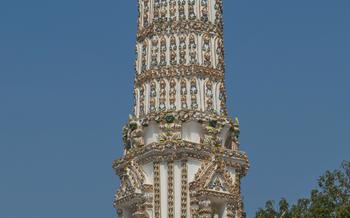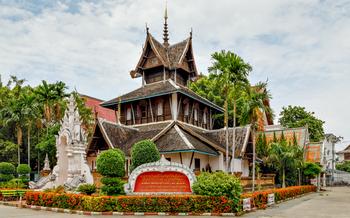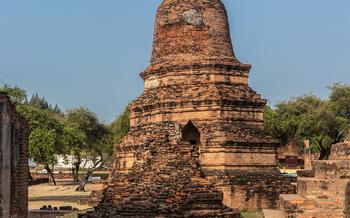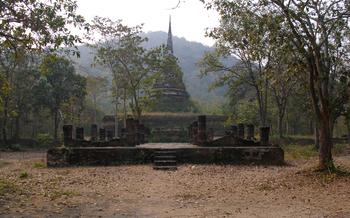
Wat Luang
- Wat Luang: A Historical Gem
- Location: A Sacred Retreat
- Exploring the Temple Grounds
- The Main Buddha Image
- Other Buddha Images and Statues
- The Ordination Hall (Ubosot)
- The Assembly Hall (Wihan)
- The Bell Tower and Drum Tower
- The Sala and Resting Areas
- The Temple Museum: A Treasure Trove of History and Culture
- Insider Tip: Off-the-Beaten-Path Gems
Wat Luang: A Historical Gem
Wat Luang, nestled in the heart of Phrae, Thailand, stands as a testament to the rich history, intricate architecture, and profound religious significance that permeates the region. Built in the 14th century, this ancient temple has witnessed centuries of devotion, cultural exchange, and architectural evolution, earning its place as one of Phrae's most revered and cherished landmarks.
The temple's architectural prowess is evident in its intricate carvings, graceful stupas, and imposing ordination hall, showcasing the artistic mastery of Lanna artisans. Wat Luang is not merely a place of worship but also a treasure trove of cultural heritage, reflecting the deep-rooted Buddhist traditions and beliefs that have shaped Phrae's identity.
As a sacred site, Wat Luang exudes an aura of tranquility and spirituality, inviting visitors to immerse themselves in its serene atmosphere and connect with the divine. The temple's religious significance extends beyond its physical structure, as it serves as a vibrant center for community gatherings, festivals, and ceremonies, fostering a sense of unity and shared devotion among the local people.
Location: A Sacred Retreat
Wat Luang is situated in the heart of Phrae, a charming province in Northern Thailand. Its exact address is 100 Tambon Nai Wiang, Mueang Phrae District, Phrae 54000, Thailand. Reaching Wat Luang is a breeze, as it's just a short walk from the city center. Alternatively, visitors can take a tuk-tuk or songthaew, the local transportation, which cost between 30 to 50 baht.
Once you arrive at Wat Luang, you'll be greeted by a serene and tranquil atmosphere. The temple complex is surrounded by lush greenery, creating a sense of peace and tranquility. In the vicinity of Wat Luang, there are several other attractions worth exploring. Wat Phra Bat Ming Muang, a temple renowned for its ancient Buddha footprint, is only a stone's throw away. For those interested in history and culture, the Phrae National Museum offers a glimpse into the region's rich past.
For visitors seeking a comfortable stay, there are various lodging options in Phrae. From budget-friendly guesthouses to upscale hotels, there's something to suit every preference and budget. The Phrae Piman Hotel and the Riverie Hotel are popular choices among travelers. These hotels offer a range of amenities, including comfortable rooms, swimming pools, and restaurants, making your stay in Phrae a truly memorable one.
Exploring the Temple Grounds
Wat Luang's temple complex is a treasure trove of architectural marvels and spiritual significance. As you step through the gates, you'll be greeted by a serene and spacious courtyard, surrounded by a series of impressive structures. The main Buddha image, Phra Phuttha Chinnarat, is housed in the grand Ubosot, the ordination hall, which stands as the centerpiece of the complex. Its intricate carvings, colorful murals, and towering spire are a testament to the artistic prowess of Lanna artisans.
To the left of the Ubosot, you'll find the Assembly Hall, or Wihan, a multi-purpose building used for religious ceremonies, community gatherings, and meditation. Its elegant wooden structure and graceful lines exude a sense of tranquility.
Scattered throughout the grounds are several stupas and chedis, which are Buddhist monuments symbolizing the Buddha's teachings and containing sacred relics. These structures vary in size, shape, and design, each representing a different era and style of Lanna architecture.
Don't miss the Bell Tower and Drum Tower, which stand tall and majestic at the corners of the temple complex. These towers once served as a means of communication and signaling the time for religious ceremonies. Their intricate designs and symbolic significance add to the overall charm of Wat Luang.
Finally, take some time to relax and soak in the serene atmosphere at the Sala and resting areas. These covered pavilions offer a respite from the sun and are perfect for meditation, contemplation, or simply enjoying the tranquil surroundings.
The Main Buddha Image
In the heart of Wat Luang lies its most revered treasure—the Main Buddha image. Constructed in 1804, this majestic Buddha exudes an aura of serenity and spirituality. Known locally as Luang Pho To, the image stands tall, radiating compassion and wisdom.
Crafted from a single block of bronze, the Buddha is adorned with intricate gold leaf, exuding an ethereal glow. Its serene facial expression, delicate features, and graceful posture are a testament to the exceptional craftsmanship of the Lanna artisans.
The Main Buddha holds a special place in the hearts of Phrae locals, who revere it as a sacred symbol of their faith. Devotees flock to pay homage, offering prayers, flowers, and incense to seek blessings and guidance.
Legends and stories surround this revered image. One tale speaks of a time when a severe drought threatened the region. In response, the monks carried the Buddha in a procession, praying for rain. Miraculously, the skies opened up, bringing much-needed relief to the parched land.
Other Buddha Images and Statues
In addition to the primary Buddha image, Wat Luang houses a diverse collection of Buddha images and statues. These images vary in size, style, and materials, reflecting the temple's rich history and diverse artistic influences.
Some of the most notable statues include a large bronze Buddha from the Ayutthaya period, a wooden Buddha from the Lanna period, and a small gold-leafed Buddha from the Sukhothai period. Each of these images exhibits unique features and symbolism, showcasing the evolution of Buddhist art and iconography in Thailand.
The bronze Buddha, with its serene expression and intricate detailing, exemplifies the grandeur of the Ayutthaya period. The wooden Buddha, carved with meticulous precision, showcases the refined craftsmanship of the Lanna artisans. The gold-leafed Buddha, with its gleaming surface and delicate features, represents the refinement and elegance of the Sukhothai period.
These Buddha images are not merely objects of worship but also serve as valuable historical and cultural artifacts. They provide a glimpse into the beliefs, practices, and artistic traditions of the people who created them.
The temple also houses a collection of smaller Buddha statues, each with its own unique story to tell. These statues may represent different aspects of the Buddha's life or teachings, or they may be dedicated to specific deities or spirits.
Wat Luang's collection of Buddha images and statues is a testament to the temple's rich history and its enduring significance as a center of Buddhist devotion and artistic expression.
The Ordination Hall (Ubosot)
The Ubosot, also known as the Ordination Hall, is a sacred and significant structure within the Wat Luang temple complex. It serves as the primary venue for religious ceremonies, particularly ordinations, which are the rituals where individuals are initiated into the Buddhist monastic order. The Ubosot is held in high regard by both monks and laypeople, symbolizing the purity and sanctity associated with the monastic life.
Architecturally, the Ubosot at Wat Luang displays a blend of traditional Thai and Lanna styles. Its design features intricate carvings, delicate stucco work, and ornate gables that showcase the artistic prowess of local craftsmen. Inside, the hall is adorned with beautiful murals and paintings that depict scenes from the life of Buddha, as well as stories from Thai mythology and history. These artworks serve as visual representations of Buddhist teachings and provide a glimpse into the rich cultural heritage of the region.
The Ubosot is not only a place for ordinations but also serves as a venue for other religious ceremonies and rituals. Monks gather here for daily prayers, meditation sessions, and chanting of scriptures. On special occasions, such as Buddhist holidays and festivals, the Ubosot becomes the focal point for grand ceremonies that attract devotees from near and far. These events showcase the vibrant religious traditions of Thailand and offer visitors an opportunity to witness the deep reverence and devotion of the local community.
The Assembly Hall (Wihan)
The Assembly Hall, or Wihan, is a vital and functional structure within the Wat Luang temple complex. It serves as a gathering space for monks and laypeople to congregate for religious ceremonies, community events, and other activities.
In terms of architectural style and design, the Assembly Hall showcases traditional Thai elements. Intricate carvings, vibrant murals, and elegant paintings adorn the walls and ceilings, creating a visually captivating interior. The Hall's spacious layout allows for comfortable seating, accommodating large groups for various functions.
The Assembly Hall's primary function is to host religious ceremonies and rituals. Monks conduct daily prayers, chanting, and meditation sessions, inviting devotees to participate and deepen their spiritual connection. Significant religious festivals and events are also held in the Assembly Hall, drawing a large number of worshippers.
Beyond its religious significance, the Assembly Hall serves as a venue for community events and activities. Villagers gather here for meetings, social gatherings, and celebrations. Traditional Thai dance performances, cultural shows, and educational workshops are occasionally organized, fostering a sense of community and preserving local traditions.
Overall, the Assembly Hall at Wat Luang is a multifunctional space that plays a crucial role in the spiritual and cultural life of the temple and the surrounding community.
The Bell Tower and Drum Tower
The bell tower and drum tower are two striking structures that stand tall within the temple complex. The bell tower is located in the northeastern corner, while the drum tower is situated in the southeastern corner. Both towers serve as important landmarks and add to the overall grandeur of Wat Luang.
The bell tower is a multi-tiered structure with a distinctive pointed roof. It houses a large bronze bell that is used to signal the time for prayers and ceremonies. The bell is struck with a wooden mallet, producing a deep and resonant sound that reverberates throughout the temple grounds.
The drum tower, on the other hand, is a smaller and simpler structure with a single tier. It houses a large wooden drum that is played to accompany the chanting of monks during religious ceremonies. The drumbeats provide a rhythmic backdrop to the prayers and create a sense of solemnity and devotion.
The bell tower and drum tower are not only functional structures but also hold cultural and religious significance. They are symbols of Buddhist tradition and represent the importance of time and rhythm in religious practice. Visitors to Wat Luang are encouraged to climb the stairs of the bell tower and drum tower to experience the stunning views of the temple complex and the surrounding landscape.
The Sala and Resting Areas
Interspersed among the temple's structures are serene sala and resting areas, inviting visitors to pause, reflect, and soak in the tranquility of their surroundings. These sheltered platforms, often adorned with intricate carvings and colorful murals, provide respite from the tropical heat and offer a place for contemplation and meditation.
Strategically positioned throughout the temple grounds, these salas also serve as gathering places for monks and laypeople alike. Here, they engage in religious discussions, share stories, and foster a sense of community. The gentle breeze rustling through the surrounding trees and the melodious chanting emanating from the nearby temple halls create a harmonious ambiance, conducive to spiritual reflection and inner peace.
Beyond their religious significance, the salas and resting areas also cater to the practical needs of visitors. Weary pilgrims can rest their tired feet, seek shelter from the elements, or simply enjoy a picnic lunch while basking in the serene atmosphere. These spaces embody the temple's commitment to providing a welcoming and inclusive environment for all who seek solace and spiritual nourishment within its sacred grounds.
The Temple Museum: A Treasure Trove of History and Culture
Wat Luang boasts a treasure trove of history and culture within its walls, and the temple museum is a testament to this rich heritage. Step inside this dedicated space, and prepare to be captivated by a collection of historical artifacts, religious relics, and cultural treasures that bring the temple's past to life.
Among the exhibits, you'll find ancient scriptures and manuscripts, each carefully preserved and telling stories of the temple's origins and teachings. Gaze upon intricate Buddha images, finely crafted statues, and ceremonial objects that showcase the artistic prowess and devotion of past generations.
The temple museum not only serves as a repository of historical artifacts but also as a hub for education and cultural exchange. Interactive displays, informative panels, and knowledgeable guides help visitors understand the significance of the exhibits and their connection to the temple's religious and cultural traditions.
For those seeking a deeper immersion into the history and culture of Wat Luang, the temple museum is an invaluable resource. It offers a unique opportunity to explore the temple's rich heritage, gain insights into its spiritual significance, and appreciate the artistry and craftsmanship that have shaped its identity over the centuries.
Insider Tip: Off-the-Beaten-Path Gems
While Wat Luang offers an abundance of must-see attractions, venturing off the beaten path can lead to hidden gems and unique experiences. Explore the surrounding gardens, where you might find secluded meditation spots amidst lush greenery. Discover the temple's lesser-known shrines and Buddha images, each with its own story to tell. Engage with the local monks and ask about their daily lives and practices. They may share insights and anecdotes that provide a deeper understanding of the temple's significance. Remember to be respectful and mindful of their time and commitments.
Seek recommendations from local tour guides or ask friendly locals for their favorite spots within the temple complex. They may suggest hidden viewpoints, peaceful corners, or specific ceremonies worth witnessing. Explore the temple's surroundings, where you might find nearby markets, traditional craftspeople, or charming cafes that offer a taste of local culture. These off-the-beaten-path experiences will enrich your visit to Wat Luang and provide a deeper connection to the temple's history, spirituality, and local community.




